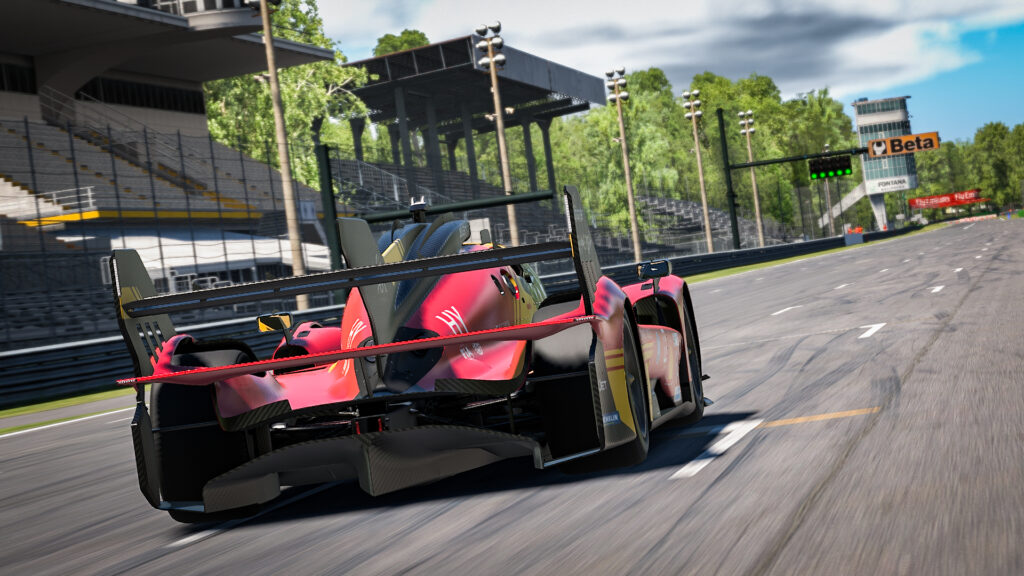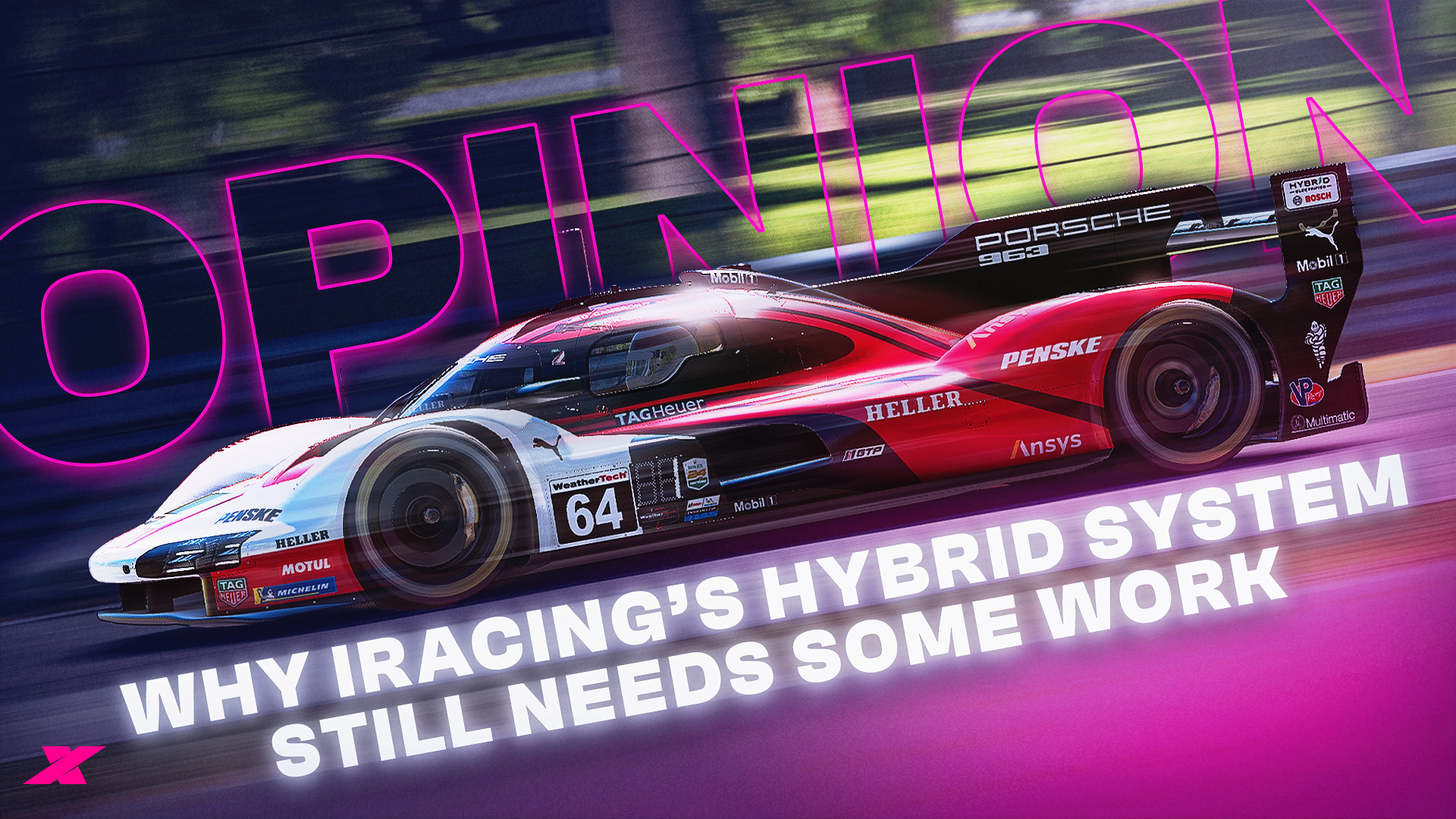Since introducing the BMW M Hybrid V8 to the sim nearly three years ago, iRacing’s GTP category hasn’t featured a realistic hybrid system.
In real-world IMSA or World Endurance Championship (WEC) races, applicable Hypercars use hybrid assistance to improve fuel efficiency, but in iRacing, battery power boosts performance, as I demonstrated in tests last year.
However, with its Season 4 2025 build, iRacing has finally moved to address this issue, resulting in a ‘complete overhaul’ of the system.
But does it now match the realistic approach taken by Le Mans Ultimate in this regard? Check out my thoughts below.
Rules is rules
The Hypercar ruleset used across IMSA and WEC can differ in some areas, but in terms of hybrid systems, they hold a common theme: virtual energy.
This is a catch-all term to describe the combined output of fuel from an LMDh and LMH Hypercar’s internal combustion engine (ICE) and the electrical energy produced by its motor generator unit (MGU) that can be used over a race stint.

Focusing on IMSA for this example, the LMDh and LMH cars that compete in the GTP category are only allowed to produce a combined 500 kW (671 bhp) at one time, split between the MGU and ICE, with a total mandated stint energy allowance of 255.6 kWh.
However, if the organisers deem it necessary, these figures can be increased or decreased depending on their Balance of Performance (BoP) calculation, which ensures performance parity between each car, based on weight, power and aerodynamic factors.
The combined power output figure is monitored by a torque sensor on the driveshaft, and exceeding it, even for a split-second, is heavily punished. Likewise, when a car exceeds its mandated total amount of virtual energy in a stint, an initial 100s stop-and-go penalty is dished out, with heavier punishments for repeat offenders.
Teams can also adjust the ratio of ICE fuel in their cars’ virtual energy allowance, with lower fuel loads resulting in shorter pit stops, making virtual energy management crucial to race performance.
It’s exciting stuff, I know.
On-track management
IMSA teams can alter the deployment strategy of their MGUs to maximise speed and efficiency over a lap, with the Williams Advanced Engineering-developed hybrid system apparently producing between 29-51 kW (40-68 bhp), depending on BoP.
Drivers can also tune the regenerative effect of the MGU on-the-fly, combining both factors to mitigate a myriad of factors, including energy efficiency, brake temperatures and car balance.
However, since the Season 4 2025 build, it’s not possible to alter the MGU’s behaviour in iRacing.

Hypercars in iRacing
‘Features like regen and friction brake blending are now handled entirely in the source code,’ stated an iRacing forum post, describing the sim’s new hybrid system.
‘For the GTP cars, we have made two fundamental changes. The first is that we have blended the output of the internal combustion engine (ICE) and motor generator unit (MGU), so total output remains the same regardless of whether or not the MGU is deploying,’ the statement continued, noting the positive steps iRacing has made in integrating MGU and ICE power.
However, the opening gambit of ‘I’d like to set expectations about our hybrid system update’ doesn’t instil much confidence on its overall accuracy: the phrase ‘set expectations’ rarely carries positive connotations…
‘There is no real need for adjustable deployment strategy, which will be locked at… 50% battery state of charge target,’ explained iRacing, indicating that drivers cannot alter hybrid settings in iRacing’s Hypercars at all.
‘Essentially, the hybrid platform on these cars will be invisible – you simply get in and drive them as you would a car with only an ICE’.
This is the key takeaway: iRacing’s GTP cars now drive just like any other racecar, making their complicated hybrid systems virtually redundant.
The LMH Ferrari 499P has also been given similar treatment. Like its LMDh counterparts, the Ferrari uses a hybrid system that cannot be manipulated in any way by iRacers, although there are plans to unlock some MGU options in future, allowing drivers to alter the car’s high-speed balance.

Strangely, there also appears to be a bug with the 499P, where braking increases the audio volume of the engine and MGU, which will be patched quickly, no doubt.
Virtually non-existent
Virtual energy, which is used in both IMSA and WEC, has also not been implemented, with iRacing claiming it doesn’t make sense given the changes to its hybrid system.
“We have elected not to implement the Virtual Energy concept on the GTP’s and 499P. We did not prioritize this feature because, in our environment, its benefits are limited in scope. Where in reality it is a challenge to properly account for various engine and drivetrain architectures to ensure performance parity and economy, this is not the case in our world where these are items we have complete control over. As such, the practical impact to you would be more or less a change to the displayed unit of fuel from Litres or Gallons to Joules or Percentage only’.
Given iRacers can’t manually control hybrid functions, it does make sense not to introduce the virtual energy concept, but it feels like iRacing is missing the point somewhat.
From personal experience, hardcore sim racers want to have full control of a car’s systems. They want to emulate our real-world racing heroes. They want realism and accuracy. Homogenising the GTP class (plus the Ferrari 499P) in this manner detracts from the immersion of driving a virtual Hypercar.
Some may argue that the MGU has a minor performance effect in racing, which is partly true. However, managing the MGU manually can increase your car’s performance by shortening brake distances, managing brake temperatures and improving efficiency. It’s important in real racing, so why can’t it be important in the virtual world?

The case for the defence
There’s a case to be made for agreeing with iRacing’s actions, however, in that most races involving the GTP/499P cars on the service are fairly short, with endurance not really a factor. However, this is not true for many of iRacing’s blue riband Special Events.
In LMU, MGU management isn’t as complicated as you’d imagine, either. Setting the highest regen rate for the MGU is the best strategy across all cars and conditions, for example. After that, it’s a case of increasing or decreasing the MGU’s deployment rate (known as ‘motor map’) to ensure your car’s battery doesn’t reach zero or 100%.
The MGU can’t generate any more electrical power under braking while the battery is at 100%, so its extra ‘engine braking’ service will be rendered ineffective. Essentially, iRacing’s hybrid system manages this for you, preventing brake lock-ups caused by a brake bias imbalance.
However, minimising mistakes and managing onboard systems is part of what makes driving virtual racecars such a rewarding experience, and by taking control away from users, immersion is reduced.
iRacing pitches itself as the ‘most authentic motorsport racing game on your PC’, which is why I think its new Hypercar hybrid system needs to be reevaluated.
Shop sim racing equipment
[adinserter name=”Asetek”]
[adinserter name=”Moza Racing”]
[adinserter name=”Sim-Lab”]
[adinserter name=”Fanatec”]





Chat with the Community
Sign Up To CommentIt's completely Free